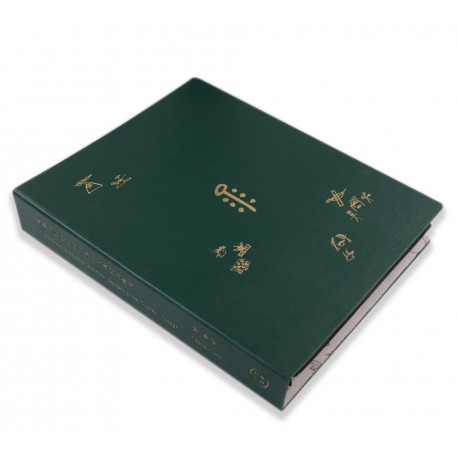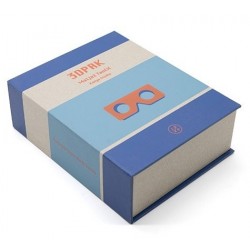Aucun produit
Time from Different Sources (*signé*)
978-988145750-9
Neuf
.Stock épuisé.
Titre complet : "Time from Different Sources : Images from Ciman Village"
Présentation de l'éditeur :
"Dans cet ensemble, Cheng utilise le récit polyphonique pour présenter la réalité d'un village Naxi dans le sud-ouest de la Chine pendant l'urbanisation. Ce livre, en réponse à la série «complète», est une polyphonie visualisée.
Il n'est pas exagéré de dire que c'est un livre fait à la main en production de masse."
Extrait de la présentation par l'artiste (texte complet en anglais en bas de page) :
"Cette oeuvre est une réponse aux aléas de l'urbanisation.
Les quatre composantes de l'œuvre parlent respectivement du temps géologique, du temps contemporain dans le village, du temps historique dans le village, et de la tension du corps physique existant dans ce temps.
Je tente de reconstruire ces situations contemporaines coexistantes à travers une approche narrative polyphonique. Au lieu d'un récit simplifié, la réalité complexe pourrait être représentée avec toute sa complexité et sa flexibilité grâce à cette méthode.
Dans le processus, la perspective d'une figure fictive et plusieurs fils narratifs sont construits. Ils émergent de détails inaperçus et s'entrelacent au fur et à mesure que le récit progresse, se dilatant et se contractant jusqu'à ce que toutes les images soient reliées entre elles.
De cette façon, les formes se replient dans le récit dominant, tandis que les tourbillons et les sous-courants émergent dans la chronologie linéaire. Finalement, ces images forment une analyse de la réalité qui découvre le discours caché sous sa surface lisse."
Ce livre est la seconde collaboration (après The Naming of a River) entre le photographe Cheng Xinhao et l'éditeur Jiazazhi.
Ce second livre, de présentation très élaborée voire complexe, est un classeur en simili-cuir dans lequel les pages sont d'innombrables dépliants de tailles et de fonctionnements différents, rendant ainsi compte de la complexité de la géographie et de l'urbanisation dans la région de la ville de Lijiang et du village de Ciman, le long de la rivière Green Dragon.
NB : En conséquence, il est difficile d'indiquer un nombre de pages pour ce livre...
Jiazazhi, 2017 (800 ex.)
Format : 25.5 x 30.5 x 4 cm
*Signé*
Neuf - Aucun défaut
En savoir plus
Présentation par l'artiste ("Artist Statement") : [adaptations mineures par L'Ascenseur Végétal]
"From the Jade Dragon Mountain, there flows a river called Green Dragon River, through a village called Ciman. Ciman Village existed before Lijiang, the largest city in this area. Lijiang was built by a group of migrants from the north, who called themselves the Naxi and established there.
Lijiang became the gateway of Tibet from the Han lands, and at that time, Ciman Village was the first stop as the trading caravans entered Lijiang city. The horses and caravans stopped at the village to rest. The business of the village flourished. As time goes, new roads were built bypassing the village; horses were replaced by cars, and thus Ciman regained its peace.
Every year, the waters of the Qinglong (Green Dragon) River rise and fall. Sometimes the river breaks its banks and floods the surrounding fields. The crops in the fields sprout, thrive, ripen and decay at their appointed times, year in and year out. The Naxi have lived on farming for generations. Each year in April, the village is filled with pear blossoms.
Today, Ciman Village is still the first town you pass as you enter Lijiang area. The Huangshan Great Bridge connecting the highway sweeps over the head of the village. The city has grown, while the village has shrunk. Few fields are seen along the banks of the Qinglong River today. The residents of Ciman Village no longer work the fields, and they seem to have accepted the constant roar of traffic over their heads.
The days still pass on. The Naxi People, singing their ancient songs, gradually grow old. The youngs gradually leave this place. In the empty space where the city has yet to reach, a new village has risen on the eastern bank of the Qinglong River. People from other provinces have set up shop here, firing bricks, fixing cars, raising pigs and recycling scrap.
If the city does not come here soon, these new migrants may settle permanently, becoming the new locals. The seemingly tranquil village is being rapidly changed. Here, times from different sources unfold in parallel in everyday life, struggle against each other, and finally homogenized, or find their ways to live together.
This artwork is a response to these contingencies of urbanization.
The four components of the artwork speak respectively of geological time, contemporary time in the village, historical time in the village, and the tension of the physical body existing within this time.
I attempt to reconstruct these coexisting contemporary situations through a polyphonic narrative approach. Instead of a simplified narrative, the complex reality could be represented with its full complexity and flexibility through this method.
In the process, the perspective of a fictitious figure and multiple threads are constructed. They rise from unnoticed details, and entangle each other as the narrative progresses, expanding and contracting against each other until all of the images are linked together.
Through this way, folding forms in the overarching narrative, while eddies and undercurrents emerge in the linear timeline. Eventually, these images form an analysis of reality that uncovers the discourse lying concealed under its smooth surface."
-- Cheng Xinhao
.Stock épuisé. Présentation par Jiazazhi : [traduction L'Ascenseur Végétal] "10 Days in Kraków est présenté sous une forme à mi-chemin entre le récit de voyage et le « scrapbook ». Bien que le livre n'aie pas d'index, trois chapitres apparaîtront dans une structure qui semble fragmentée : Guerre, Ville, et Connexion (de ici à là, et de moi à toi). Le...
.Seulement deux exemplaires disponibles - Épuisé chez l'éditeur.Portraits en 3D réalisés en Corée du Nord en 2014.Jiazazhi Press, 2016 Format de la boîte : 15.5 x 19.5 x 6.5 cm Contenu : lunettes 3D, 65 cartes 3D, 5 cartes "postales" 3D, livret descriptif (chinois & anglais). *Signé* Neuf - Aucun défaut
49,00 €Rupture de stockPrésentation par l'artiste : «Mon complexe de théâtre est venu de chez moi, je vis dans une cour de théâtre remplie de jeux et d'observations, la vie théâtrale a enrichi mes connaissances sur les différents rôles à tous les temps et dans tous les pays. Des éléments étrangers ont été ajoutés à la culture et à l'art traditionnels, locaux et folkloriques,...
69,00 €Disponible



























